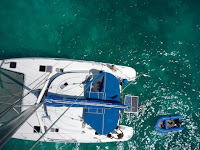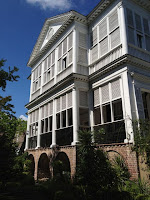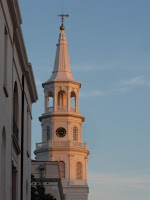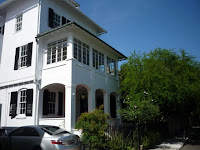[Maryanne]After the loss of Footprint, the winter and spring of 2012 has been spent searching for our next boat. Kyle has expended most of this effort and energy, both in the research and in the actual visits, trials, surveys etc. It’s been frustrating, expensive, and highly disappointing. Of course one Spring is not such a great length of time, and in hindsight it really hasn’t taken so long to find our new partner in adventure, but the process was wearisome and we were never certain it would find a conclusion.
We spent $1000’s, and sacrificed many precious weekends we’d have otherwise spent together, chasing phantoms of boat listings. Most, once seen in person, had little resemblance to their listings, or just weren't right for us once we'd seen the layout. Some had cut-and-paste older listings, neglecting to reflect the many additional years of wear and tear and breakages. One notable other listed as actual installed equipment everything the owner had one day hoped to put aboard. Time and again I arrived after a long an expensive journey to find the actual boat bore little resemblance to its slick advertisement. Another failed at sea trial twice with engine problems. And so it went on and on, as funds and hopes dwindled as one perspective boat after another gradually made the transition from the hoped for end of our shore life to disappointment.
Eventually we found Begonia. For sale by a family with two children, having adventured across the Atlantic and back, and now returning to the USA for traditional schooling and a ‘normal’ life until the next adventure lures them away.
Kyle made contact with the owners while they were in Puerto Rico on their journey back from Africa to the USA. We agreed Kyle would intercept with them in the Bahamas for a few days to check out the boat. With all that had transpired so far with the great boat search, Kyle arrived with a healthy dose of pessimism, but from his first sighting of the boat it became more and more apparent that it was in good condition, well maintained, and well kitted out for our needs. The owners were conscientious, the listing honest, and their welcome warm. As a bonus we found much in common and Kyle especially enjoyed their company on his solo trip to view the boat. An amicable agreement was quickly reached; they would sell the boat for a fair price, in exchange for our taking it off their hands just as soon as they delivered it to the USA. This minimized their storage and listing expenses, and enabled them to plan the next chapter of their lives, and enabled us to start planning ours. (Subject to survey)
Begonia is a 2001 Fountaine-Pajot Athena 38 sailing Catamaran. We toyed with the idea of changing her name, but eventually agreed Begonia was just fine, and we’d stick with it. We also decided to continue our adventures on SV-Footprint.blogspot.com rather than start yet another blog.




Begonia in the Bahamas
[Kyle] I have to admit that ever since we began researching catamarans prior to purchasing Footprint, I have coveted an Athena 38. The high thirties is a good sweet spot between manageability under sail and comfort below. In that range, the Athena has a reputation for being one of the best designs of all time.
Every now and then after a rough passage or in moments of whimsy, Maryanne would ask, “If we won the lottery or some unknown rich great uncle left us loads of money and you could have any boat you wanted, what would it be?” My answer was always a swift, “Athena 38” It was a pure pipe dream. Athenas were always so far out of our price range that we wouldn’t even allow ourselves to consider it a real option. When we bought Footprint, they were selling for at least two Footprints. It might as well have been ten.
Well, between a bad economy and more time for normal depreciation to take effect, owning one became a real possibility for us. Even so, they are in high demand. Owners tend to hang on to them. The handful that are for sale in the world go quickly. We signed a contract in the Bahamas and we wired the deposit the day I got home.
On Monday 11 June 2012, after agreeing weeks before, Begonia was officially ours, the bank account was much reduced, and we were the proud owners of our new home. The survey turned up a few items that needed to be addressed. To those, we had our own list of planned upgrades and improvements. Our insurance company wouldn’t cover tropical storm damage if the boat was south of 31° after the first of July.
Ideally we’d have spent time day sailing and getting to know her, but already we found ourselves on a schedule, and wanting the boat North for the summer, agreed to sail off shore together to Charleston. This meant we arrived at the boat with bags of emergency and foul weather equipment, grocery lists, and to-do lists all with just a few hours to complete before we headed out. Our first time alone aboard the boat would be the 425 nautical mile passage from Fort Lauderdale to Charleston.
The first couple of days were busy. We were adjusting to the new boat at the same time we were adjusting from a normal diurnal sleep pattern to watch keeping. We had a great sail, though. 24 hours after leaving Fort Lauderdale, we were 275 miles away. I spent my whole night-watch watching the boat sail double-digit speeds. We were so pleased. A cold front was predicted to come in near the end of our passage and bring strong headwinds. We could use all of the speed we could get to beat it.
The wind died. We slowed down to normal speeds and then further to a crawl. The headwinds came and increased and we found ourselves having to beat to windward the last 70 miles into Charleston harbor. Those of you that have read the blog for any length of time know that I hate beating to windward. In Footprint, downwind and upwind sailing were two completely different experiences. Downwind was fast and smooth, upwind could be a bashing nightmare. In the Athena, upwind sailing seems to be…well, just sailing. Those last 70 miles had none of the drama to which we were accustomed. They were also smooth, fast sailing; This is due to the Athena’s tremendous bridge deck clearance, which give waves somewhere to go other than pounding the structure. Of course upwind sailing often means you can’t go in exactly the direction you’d like (boats just won’t sail into the wind directly), so we managed a little tacking practice too.
In the end, it took us 2½ days to cover the distance – a day and a half less than planned. We decided to use the extra time by finding a quiet anchorage in which we could quietly readjust to normal sleep patterns and take a moment’s rest from the long boat search to enjoy our new home.

Sunset at sea
We're very happy with our new home, more pictures will follow (eventually)!































